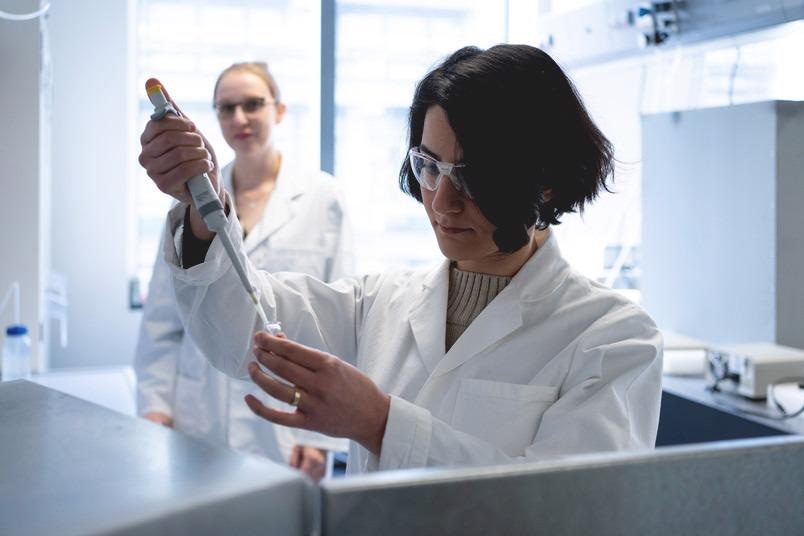Scientists from the RESOLV Cluster of Excellence at Ruhr-Universität Bochum (RUB) have used current and voltage measurements on separate nanoparticles to prove that the capacitively stored charge at platinum interfaces can be considerably higher than formerly believed. They credit this to a unique arrangement and bonding of water molecules.
 Dr. Mahnaz Azimzadeh Sani and Dr. Julia Linnemann (from right) are part of the team that found unexpectedly high electrochemical capacities on individual gold and platinum nanoparticles. (Image Credit: © RUB, Kramer).
Dr. Mahnaz Azimzadeh Sani and Dr. Julia Linnemann (from right) are part of the team that found unexpectedly high electrochemical capacities on individual gold and platinum nanoparticles. (Image Credit: © RUB, Kramer).
For that reason, an international team headed by Professor Kristina Tschulik, whose concepts were awarded an "ERC Starting Grant" by the European Research Council in 2020, collaborated with partners from Israel and France. The authors explain their findings in the online issue of the journal Angewandte Chemie International Edition, published on December 19, 2021.
Although interfaces between water and metals are the local areas where key processes of energy technologies such as water splitting take place, comparably there is less awareness about their structure and alterations during such processes.
For over a century, the scientific explanation of such interfaces has been established on the model of the so-called electrochemical double layer. It shows that charge carriers in an aqueous solution are progressively arranged in the boundary region to the metal, to make up for surplus electrical charges on the metal side. During the process, water molecules separate the opposing charges.
Resembling a common plate capacitor, this nanoscopic charge separation in the interface enables energy to be captured and discharged later. Processes wherein the molecular structure of the electrochemical double layer varies are significant to a number of green technologies, such as fuel cells and supercapacitors.
Thousands of Times Smaller Than the Diameter of a Human Hair
Nanoparticles, which are thousands of times smaller than the diameter of a human hair, are explored for such technical uses. Owing to their profitable ratio of process-relevant surface area to volume, they provide good conditions for this.
In order to track down the capacitance and the rearrangement processes in the electrochemical double layer on platinum and gold nanoparticles, it was crucial to develop a method with which precise discharge currents can be measured on individual nanoparticles in solution.
Kristina Tschulik, Study Team Lead and Professor, Ruhr-Universität Bochum
Otherwise, it would be impossible to differentiate effects associated with the electrochemical double layer from effects triggered by the interaction of adjoining nanoparticles, since billions of them are found on a conventional electrode.
The Iranian researcher Dr. Mahnaz Azimzadeh Sani, who was backed by the German Academic Exchange Service (DAAD), utilized so-called colloidal nanoparticle dispersions. There, nanoparticles are divided from each other and excellently dispersed in aqueous solution, occasionally striking a biased microelectrode.
Using computer-aided molecular dynamics simulations, on which scientists from the RUB and the Université Paris-Saclay and Sorbonne Université in Paris worked, it was feasible to detect comparisons and variances in voltage-dependent measured capacitive currents of various types of nanoparticle dispersions.
The measured surprisingly high capacitances are linked to the increased accumulation of dissolved ions in regions between a compact water layer attached to platinum and an immediate water layer of a different orientation.
"Furthermore, water molecules are detached from the metal surface when more negative voltage is applied" explains Dr. Julia Linnemann, team leader at Tschulik's chair.
Going forward, the RUB researchers are keen to discover whether and why the double-layer structure is different on large electrodes comprising many nanoparticles, so as to make the findings practical for commercial purposes.
Funding
This study received funding from the German Research Foundation within the RESOLV EXC 2033 Cluster of Excellence - project number 390677874. Further financial support was received from the European Union within the ERC-Starting-Grant MitiCat (project number 949724), Stiftung Mercator (project number 18032), and the German Academic Exchange Service (DAAD), among others.
Journal Reference:
Sani, M. A., et al. (2021) Unexpectedly High Capacitance of the Metal Nanoparticle/Water Interface: Molecular-Level Insights into the Electrical Double Layer. Angewandte Chemie International Edition. doi.org/10.1002/anie.202112679.